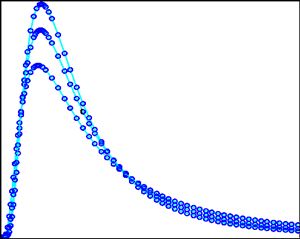Selection combining diversity for Fisher-Snedecor composite fading model under interference
DOI:
https://doi.org/10.3103/S0735272723070014Keywords:
selection combining diversity, interference, fading, shadowingAbstract
The performance of the Fisher-Snedecor (F) fading model with selection combining (SC) diversity scheme over the interference-limited system is presented in this paper. The probability density function (PDF) and cumulative distribution function (CDF) are derived without SC diversity under single-user interference. After that, the expressions of CDF and PDF for SC diversity are computed. The PDF is presented for different desired and interferer multipath fading parameters. The results are also illustrated in terms of outage probability (OP) for independent but not necessarily identically distributed (INID) and independent identically distributed (IID) variates. The higher number of diversity branches shows better OP performance.
References
- P. M. Shankar, Fading and Shadowing in Wireless Systems. New York, NY: Springer New York, 2012, doi: https://doi.org/10.1007/978-1-4614-0367-8.
- S. K. Yoo, S. L. Cotton, W. G. Scanlon, G. A. Conway, “An experimental evaluation of switched combining based macro-diversity for wearable communications operating in an outdoor environment,” IEEE Trans. Wirel. Commun., vol. 16, no. 8, pp. 5338–5352, 2017, doi: https://doi.org/10.1109/TWC.2017.2709298.
- B. Sharma, D. Koundal, “Cattle health monitoring system using wireless sensor network: a survey from innovation perspective,” IET Wirel. Sens. Syst., vol. 8, no. 4, pp. 143–151, 2018, doi: https://doi.org/10.1049/iet-wss.2017.0060.
- A. Kumar, S. Sharma, N. Goyal, A. Singh, X. Cheng, P. Singh, “Secure and energy-efficient smart building architecture with emerging technology IoT,” Comput. Commun., vol. 176, pp. 207–217, 2021, doi: https://doi.org/10.1016/j.comcom.2021.06.003.
- G. Femenias, “MGF-based performance analysis of selection diversity with switching constraints in nakagami fading,” IEEE Trans. Wirel. Commun., vol. 5, no. 9, pp. 2328–2333, 2006, doi: https://doi.org/10.1109/TWC.2006.1687752.
- P. Bithas, P. Mathiopoulos, S. Kotsopoulos, “Diversity reception over generalized-K (KG) fading channels,” IEEE Trans. Wirel. Commun., vol. 6, no. 12, pp. 4238–4243, 2007, doi: https://doi.org/10.1109/TWC.2007.4400789.
- P. Theofilakos, A. Kanatas, G. Efthymoglou, “Performance of generalized selection combining receivers in K fading channels,” IEEE Commun. Lett., vol. 12, no. 11, pp. 816–818, 2008, doi: https://doi.org/10.1109/LCOMM.2008.080779.
- T. Bhaskar Reddy, R. Subadar, P. Sahu, “Outage probability of SC receiver over exponentially correlated K fading channels,” IEEE Commun. Lett., vol. 14, no. 2, pp. 118–120, 2010, doi: https://doi.org/10.1109/LCOMM.2010.02.091749.
- S. Khatalin, “Performance of dual-branch selection combining diversity systems in non-identical Nakagami-q (Hoyt) fading channels,” IET Commun., vol. 4, no. 5, p. 585, 2010, doi: https://doi.org/10.1049/iet-com.2009.0445.
- R. Subadar, A. D. Singh, “Performance of SC receiver over TWDP fading channels,” IEEE Wirel. Commun. Lett., vol. 2, no. 3, pp. 267–270, 2013, doi: https://doi.org/10.1109/WCL.2013.13.120778.
- A. D. Singh, R. Subadar, “Capacity analysis of M-SC receivers over TWDP fading channels,” AEU - Int. J. Electron. Commun., vol. 68, no. 2, pp. 166–171, 2014, doi: https://doi.org/10.1016/j.aeue.2013.08.001.
- A. Abdi, M. Kaveh, “K distribution: an appropriate substitute for Rayleigh-lognormal distribution in fading-shadowing wireless channels,” Electron. Lett., vol. 34, no. 9, p. 851, 1998, doi: https://doi.org/10.1049/el:19980625.
- H. Al-Hmood, H. S. Al-Raweshidy, “Selection combining scheme over non-identically distributed Fisher-Snedecor F fading channels,” IEEE Wirel. Commun. Lett., vol. 10, no. 4, pp. 840–843, 2021, doi: https://doi.org/10.1109/LWC.2020.3046519.
- E. A. Neasmith, N. C. Beaulieu, “New results on selection diversity,” IEEE Trans. Commun., vol. 46, no. 5, pp. 695–704, 1998, doi: https://doi.org/10.1109/26.668745.
- M.-S. Alouini, M. K. Simon, “An MGF-based performance analysis of generalized selection combining over Rayleigh fading channels,” IEEE Trans. Commun., vol. 48, no. 3, pp. 401–415, 2000, doi: https://doi.org/10.1109/26.837044.
- J. P. Pena-Martin, J. M. Romero-Jerez, C. Tellez-Labao, “Performance of selection combining diversity in η–μ fading channels with integer values of μ,” IEEE Trans. Veh. Technol., vol. 64, no. 2, pp. 834–839, 2015, doi: https://doi.org/10.1109/TVT.2014.2326333.
- S. R. Panić, M. C. Stefanović, A. V. Mosić, “Performance analyses of selection combining diversity receiver over –μ fading channels in the presence of co-channel interference,” IET Commun., vol. 3, no. 11, p. 1769, 2009, doi: https://doi.org/10.1049/iet-com.2009.0023.
- R. Annavajjala, A. Chockalingam, L. B. Milstein, “Performance analysis of coded communication systems on Nakagami fading channels with selection combining diversity,” IEEE Trans. Commun., vol. 52, no. 6, pp. 1030–1030, 2004, doi: https://doi.org/10.1109/TCOMM.2004.829502.
- R. Subadar, P. Das, “Performance of L-SC receiver over K-fading channels,” in 2017 8th International Conference on Computing, Communication and Networking Technologies (ICCCNT), 2017, pp. 1–4, doi: https://doi.org/10.1109/ICCCNT.2017.8203908.
- S. K. Yoo, S. L. Cotton, P. C. Sofotasios, M. Matthaiou, M. Valkama, G. K. Karagiannidis, “The Fisher–Snedecor F distribution: A simple and accurate composite fading model,” IEEE Commun. Lett., vol. 21, no. 7, pp. 1661–1664, 2017, doi: https://doi.org/10.1109/LCOMM.2017.2687438.
- A. Singh, H. Shankar, “MGF based analysis of interference limited system over Fisher-Snedecor fading channels,” in 2022 International Conference on Signal and Information Processing (IConSIP), 2022, pp. 1–4, doi: https://doi.org/10.1109/ICoNSIP49665.2022.10007510.
- M. K. Alshawaqfeh, O. S. Badarneh, F. S. Almehmadi, “Performance analysis of digital transmission in interference-limited networks,” Telecommun. Syst., vol. 79, no. 2, pp. 233–247, 2022, doi: https://doi.org/10.1007/s11235-021-00854-2.
- A. D. Borah, M. A. Hussain, J. Bora, “Analysis of interference alignment based multi-user MIMO precoding,” Radioelectron. Commun. Syst., vol. 64, no. 11, pp. 612–618, 2021, doi: https://doi.org/10.3103/S0735272721110054.
- V. N. Mohammed, N. Srinatha, P. S. Mallick, L. Nithyanandan, “Interference mitigation in uplink STBC MC-CDMA system based on PIC receiver,” Radioelectron. Commun. Syst., vol. 60, no. 11, pp. 485–494, 2017, doi: https://doi.org/10.3103/S0735272717110036.
- I. S. Gradshteyn, I. M. Ryzhik, Table of Integrals, Series, and Products, 7th ed. Academic Press, 2007, uri: https://www.academia.edu/36550954/I_S_Gradshteyn_and_I_M_Ryzhik_Table_of_integrals_series_and_products_Academic_Press_2007_.
- A. P. Prudnikov, Y. Brychkov, O. I. Marichev, Integrals and Series. Volume 3: More Special Functions. New York-London: Gordon and Breach, 1989.


